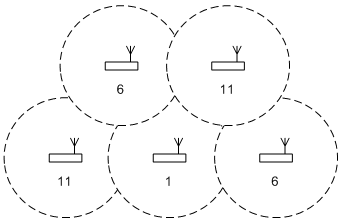
IEEE 802.11b and g radios operate in the frequency range between 2.4 and 2.483 GHz. IEEE 802.11a operates in the frequency range from 5.725 to 5.850 GHz. These are often referred to as the "2.4 GHz" and "5GHz" bands.

The bands are divided into channels so more than one radio can operate in a given area. For example, IEEE 802.11b and g are divided into 11 channels, but their frequencies overlap. There are only three non-overlapping channels: 1, 6 and 11.
WiFi uses spread spectrum modulation, rather than a single carrier frequency. The signal is spread across the frequencies in the band. This is done either by rapidly shifting carrier frequencies within the band or by sending information in parallel over sub-channels. In either case, the signal appears to be weak noise to a receiver that is not tuned to look for it.
(An interesting side note is that frequency hopping spread spectrum was invented by the actress Heddy Lamar and the composer George Antheil during World War 2).
IEEE 802.11b has a theoretical speed of up to 11 Mbps, and 802.11g and 802.11a have speeds up to 54 mbps. The different speeds use different modulation methods.
As signal strength decreases, WiFi radios automatically switch to more conservative modulation schemes, thereby lowering transmission speed. For example, 802.11b operates at 11, 5.5, 2, or 1 mbps depending upon signal strength.
WiFi throughput is also cut by a complex media access algorithm. For example, a radio must send a request to send message, then wait for a reply before transmitting data. Actual application level data transfer rates are around half of the theoretical speeds.
The commercial success of WiFi is due to standardization and the fact that it operates in license free frequency bands. You do not need a license to operate in the 2.4 and 5 GHz bands as long as your radio complies with the FCC's power and antenna limits. WiFi radios are compliant.
The power limitations restrict WiFi radios to ranges of a few hundred feet. With highly directional antennae, people have reached distances of many miles using standard WiFi radios.